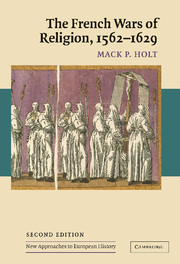Book contents
- Frontmatter
- Contents
- List of maps and figures
- Acknowledgements
- Preface to the Second Edition
- Chronological table of events
- Introduction
- 1 Prologue: Gallicanism and reform in the sixteenth century
- 2 ‘The beginning of a tragedy’: the early wars of religion, 1562–1570
- 3 Popular disorder and religious tensions: the making of a massacre, 1570–1574
- 4 The rhetoric of resistance: the unmaking of the body politic, 1574–1584
- 5 ‘Godly warriors’: the crisis of the League, 1584–1593
- 6 Henry IV and the Edict of Nantes: the remaking of Gallicanism, 1593–1610
- 7 Epilogue: the last war of religion, 1610–1629
- 8 Conclusions: economic impact, social change, and absolutism
- Genealogical charts
- Brief biographies
- Suggestions for further reading
- Index
- NEW APPROACHES TO EUROPEAN HISTORY
1 - Prologue: Gallicanism and reform in the sixteenth century
Published online by Cambridge University Press: 05 June 2012
- Frontmatter
- Contents
- List of maps and figures
- Acknowledgements
- Preface to the Second Edition
- Chronological table of events
- Introduction
- 1 Prologue: Gallicanism and reform in the sixteenth century
- 2 ‘The beginning of a tragedy’: the early wars of religion, 1562–1570
- 3 Popular disorder and religious tensions: the making of a massacre, 1570–1574
- 4 The rhetoric of resistance: the unmaking of the body politic, 1574–1584
- 5 ‘Godly warriors’: the crisis of the League, 1584–1593
- 6 Henry IV and the Edict of Nantes: the remaking of Gallicanism, 1593–1610
- 7 Epilogue: the last war of religion, 1610–1629
- 8 Conclusions: economic impact, social change, and absolutism
- Genealogical charts
- Brief biographies
- Suggestions for further reading
- Index
- NEW APPROACHES TO EUROPEAN HISTORY
Summary
Ever since the Middle Ages French kings were both consecrated and crowned during the coronation ceremony that marked their ascension to the throne. And though French ceremonial shared much in common with English coronations across the Channel, by the sixteenth century it was clear that the constitutional aspects of the ceremony so emphasized in England took a backseat to the liturgical nature of the coronation so heavily accentuated in France. The ceremony itself was called a sacre in France, emphasizing consecration rather than coronation. Patterned after the first such ceremony, the crowning of Charlemagne by the pope in Rome in the year 800, French coronations traditionally took place in the cathedral church of Reims with the local archbishop officiating. With the ecclesiastical and lay peers of the realm, as well as the bishops of the French church and the royal princes of the blood assembled around him, the new king was required to make explicit his duties and responsibilities to the Christian church in his coronation oath. In the first part of the oath, called the ecclesiastical oath, the king swore: ‘I shall protect the canonical privilege, due law, and justice, and I shall exercise defense of each bishop and of each church committed to him, as much as I am able – with God's help – just as a king ought properly to do in his kingdom.’
- Type
- Chapter
- Information
- The French Wars of Religion, 1562–1629 , pp. 7 - 49Publisher: Cambridge University PressPrint publication year: 2005
- 1
- Cited by

